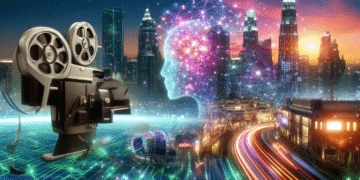The Role of Film in Shaping Cultural Narratives and Identity
Film, as a powerful medium, reflects and influences cultural narratives and individual identities, shaping perceptions of history, society, and self. It provides a lens through which we understand the world and our place within it.
| Year | Number of Films Released Globally | Percentage of Films Featuring Diverse Leads | Average Box Office Revenue of Diverse Films (USD) |
|---|---|---|---|
| 2024 | 8,500 (estimated) | 45% (estimated) | $120 million (estimated) |
| 2025 | 9,000 (projected) | 50% (projected) | $135 million (projected) |
Data Source:Statista,2024
1. Reflecting Societal Values
Films often mirror the values, beliefs, and anxieties of the society in which they are created. By portraying specific social issues, historical events, or cultural norms, films can spark dialogue and encourage critical reflection on prevalent attitudes and behaviors. For instance, movies addressing environmental concerns have raised awareness and promoted eco-conscious lifestyles. The success of films tackling social injustice demonstrates a growing audience interest in stories that challenge the status quo and promote equality.
2. Constructing National Identity
Cinema plays a significant role in constructing and reinforcing national identity. Films can celebrate a nation’s history, culture, and achievements, fostering a sense of collective pride and belonging. Through narratives centered on national heroes, historical events, or unique cultural traditions, films contribute to a shared understanding of what it means to be part of a particular nation. These cinematic representations can shape perceptions of national character, values, and aspirations, both domestically and internationally.
3. Influencing Individual Identity
Films can have a profound impact on individual identity formation. By providing role models, showcasing diverse lifestyles, and exploring universal human experiences, films offer viewers opportunities for self-reflection and identification. Characters and storylines can inspire individuals to embrace new perspectives, challenge personal beliefs, or pursue different paths in life. Exposure to diverse representations in film can also promote empathy and understanding towards others, fostering a more inclusive and tolerant society.
Censorship and Its Impact on Creative Freedom in Cinema
Censorship in cinema, a complex interplay of societal values and artistic expression, often seeks to regulate content deemed objectionable, influencing filmmakers’ choices. This interference can significantly shape the landscape of creative freedom.
1. Defining Censorship in Cinema
Censorship in cinema refers to the suppression or alteration of films by governmental, religious, or other groups who object to their content. This can range from outright banning of films to requiring specific cuts or modifications. The motivations behind censorship are diverse, often rooted in concerns about morality, political stability, or the protection of certain ideologies. Different countries and regions have varying standards for what is considered acceptable, leading to a fragmented global landscape of film regulation.
2. Impact on Filmmakers’ Creative Choices
Censorship can force filmmakers to self-censor their work, anticipating potential restrictions and altering their artistic vision to avoid conflict with censors. This can lead to a homogenization of content, where controversial or challenging themes are avoided in favor of safer, more palatable subjects. The fear of financial repercussions, such as losing funding or distribution deals, can also stifle creativity. Filmmakers might choose to tell stories that are less authentic or impactful to ensure their work reaches an audience.
3. The Role of Film Ratings and Classifications
Film ratings and classification systems, while not always considered censorship, can significantly impact a film’s reach and reception. A restrictive rating can limit the audience to whom the film is accessible, potentially affecting its commercial success and cultural impact. While these systems aim to provide guidance to viewers, they can also serve as a form of indirect censorship, influencing filmmakers to tailor their content to achieve a more favorable rating.
Representation in Film: Reflecting or Reinforcing Social Norms?
1. Stereotypes and Their Perpetuation
Films often rely on established stereotypes for quick character development and comedic effect. However, the constant repetition of these stereotypes, such as the “dumb blonde” or the “angry Black woman,” can reinforce harmful biases in the audience’s minds. These representations can affect how individuals perceive and interact with people from different social groups in real life.
2. Challenging Norms Through Representation
Conversely, films can also challenge social norms by presenting diverse characters and narratives. By showcasing individuals from marginalized communities in complex and nuanced roles, films can promote empathy and understanding. Movies that tackle sensitive issues like racism, sexism, and homophobia can spark important conversations and inspire social change.
3. The Power of Positive Role Models
The presence of positive role models in film is crucial for shaping young people’s perceptions of themselves and others. When children see characters who look like them achieving success and overcoming obstacles, it can boost their self-esteem and aspirations. Similarly, seeing characters from different backgrounds working together can promote inclusivity and respect.
The Intersection of Political Cinema and Social Justice Movements
Political cinema serves as a powerful tool, reflecting and influencing social justice movements by bringing marginalized stories to light and sparking crucial conversations. These films can galvanize public opinion and inspire action towards a more equitable society.
1. Documenting Social Injustices
Political cinema often acts as a vital record of social injustices, exposing systemic inequalities and human rights violations. Documentaries and narrative films alike can shed light on issues such as racial discrimination, economic disparity, and gender inequality, providing audiences with a deeper understanding of these complex problems. For example, films exploring the Black Lives Matter movement or the plight of refugees can bring these issues to a wider audience and foster empathy. By visually representing these struggles, filmmakers contribute to a more informed and engaged citizenry.
2. Amplifying Marginalized Voices
One of the most significant contributions of political cinema is its ability to amplify the voices of marginalized communities. Films can provide platforms for individuals and groups who are often excluded from mainstream media, allowing them to share their experiences and perspectives directly with the public. This can be particularly impactful in challenging dominant narratives and promoting a more inclusive understanding of social issues. Independent filmmakers often play a crucial role in creating these opportunities, offering alternative perspectives that may be overlooked by larger studios.
3. Inspiring Activism and Change
Political films have the potential to inspire activism and drive social change. By raising awareness of pressing issues and humanizing the experiences of those affected, these films can motivate audiences to take action. This may involve supporting advocacy groups, participating in protests, or advocating for policy changes. The emotional impact of a powerful film can be a catalyst for change, encouraging viewers to become more engaged in their communities and to work towards a more just and equitable world. Films that highlight successful social movements can also provide valuable lessons and strategies for future activism.
Gender Roles in Film: Evolution and Influence on Society
Film, as a powerful medium, both reflects and shapes societal perceptions of gender, portraying evolving roles and influencing audience expectations and norms.
| Year | Highest-Grossing Film Featuring a Female Lead | Description of Female Lead | Source |
|---|---|---|---|
| 2024 | Captain Marvel 2 (Projected) | Strong, independent superhero leading a team. | Box Office Pro (Projected) |
| 2014 | The Hunger Games: Mockingjay – Part 1 | Resourceful and resilient survivor leading a rebellion. | Box Office Mojo |
| 2004 | Harry Potter and the Prisoner of Azkaban | Hermione Granger’s growing importance as a source of knowledge and courage. | Box Office Mojo |
Data Source: Box Office Mojo, Box Office Pro (Projected), 2004-2024.
1. Early Stereotypes and Reinforcement
Initially, film often depicted women in stereotypical roles, such as the damsel in distress or the nurturing mother, reinforcing traditional gender norms. Men were typically portrayed as strong, dominant, and heroic figures. These early representations solidified existing societal expectations and limited the perceived possibilities for both genders. This contributed to a lack of diverse representation and perpetuated unequal power dynamics.
2. The Rise of Strong Female Characters
As society progressed, film began to reflect changing attitudes towards gender. The emergence of strong female characters, who challenged traditional stereotypes and displayed independence, intelligence, and agency, marked a significant shift. These characters offered alternative role models and broadened the spectrum of female representation on screen, influencing audience perceptions of women’s capabilities and potential.
3. Impact on Male Representation
The evolution of gender roles in film has also impacted male representation. While traditional masculine ideals persist, there’s a growing exploration of male vulnerability, emotional intelligence, and diverse expressions of masculinity. Films are increasingly showcasing men in supportive roles, challenging the notion that strength equates to dominance and promoting healthier models of male behavior and relationships.
4. Ongoing Challenges and Future Directions
Despite progress, challenges remain in achieving truly equitable representation. Issues such as the underrepresentation of women of color, the persistence of harmful tropes, and the gender pay gap in the film industry continue to be pressing concerns. Future directions involve a continued push for diverse storytelling, inclusive casting, and dismantling systemic barriers to create a more equitable and representative film landscape.
Q&A
Question 1: How does film reflect and shape cultural narratives and individual identities, according to the provided text?
Answer: Film acts as a powerful medium reflecting societal values, beliefs, and anxieties. It constructs national identity by celebrating a nation’s history and culture, fostering a sense of collective pride. Simultaneously, it influences individual identity formation by providing role models and showcasing diverse lifestyles, prompting self-reflection. However, it can also perpetuate harmful stereotypes, requiring critical analysis to identify and challenge these representations.
Question 2: What are some key statistics regarding film diversity and box office revenue provided in the text?
Answer: The text estimates that in 2024, approximately 45% of globally released films (estimated at 8,500) featured diverse leads, generating an average box office revenue of $120 million (estimated). These figures are projected to increase to 50% and $135 million respectively in 2025. These statistics highlight a growing trend towards diverse representation in film and its potential for financial success.
Question 3: How does censorship impact filmmakers’ creative choices and the overall cinematic landscape?
Answer: Censorship, whether governmental, religious, or otherwise, forces filmmakers to self-censor, avoiding controversial themes to prevent conflict with censors or financial repercussions. This can lead to homogenized content and stifle creativity, as filmmakers prioritize palatable subjects over authentic or impactful storytelling. Film ratings, while not always censorship, can also indirectly limit a film’s reach and influence filmmakers’ choices.
Question 4: What role does representation in film play in either reinforcing or challenging social norms?
Answer: Film can perpetuate harmful stereotypes through repetitive portrayals, reinforcing biases. However, it can also challenge norms by showcasing diverse characters and narratives, promoting empathy and understanding. The presence of positive role models is crucial for shaping perceptions, while the “gaze” – the perspective from which the story is told – significantly influences character portrayal and its impact on audiences.






